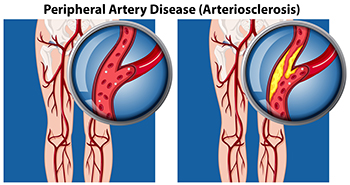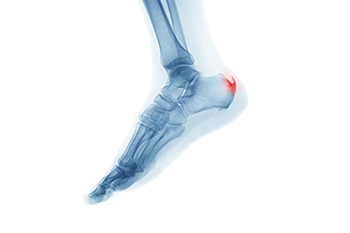Items filtered by date: February 2024
Common Signs of Peripheral Artery Disease in the Feet

Peripheral artery disease, or PAD, is a vascular condition characterized by narrowed arteries, limiting blood flow to the extremities. Recognizing the signs of PAD, particularly in the feet, is essential for early detection and treatment. One notable symptom is intermittent claudication, causing pain or cramping in the legs during physical activity. Reduced blood flow can result in coolness or numbness in the feet, along with weakened or absent pulses in the ankles and feet. Slow-healing wounds or sores, especially on the feet, may indicate compromised circulation. Changes in skin color, such as paleness or a bluish tint, could also be observed. Additionally, individuals with PAD may experience hair loss on their feet and legs, as well as shiny or thin skin. Ignoring these signs can lead to serious complications, including tissue damage and an increased risk of amputation. If you have PAD, and your feet are affected, it is suggested that you consult a podiatrist who can help you to manage this condition.
Peripheral artery disease can pose a serious risk to your health. It can increase the risk of stroke and heart attack. If you have symptoms of peripheral artery disease, consult with one of our podiatrists from Toms River Podiatrist . Our doctors will assess your condition and provide you with quality foot and ankle treatment.
Peripheral artery disease (PAD) is when arteries are constricted due to plaque (fatty deposits) build-up. This results in less blood flow to the legs and other extremities. The main cause of PAD is atherosclerosis, in which plaque builds up in the arteries.
Symptoms
Symptoms of PAD include:
- Claudication (leg pain from walking)
- Numbness in legs
- Decrease in growth of leg hair and toenails
- Paleness of the skin
- Erectile dysfunction
- Sores and wounds on legs and feet that won’t heal
- Coldness in one leg
It is important to note that a majority of individuals never show any symptoms of PAD.
Diagnosis
While PAD occurs in the legs and arteries, Podiatrists can diagnose PAD. Podiatrists utilize a test called an ankle-brachial index (ABI). An ABI test compares blood pressure in your arm to you ankle to see if any abnormality occurs. Ultrasound and imaging devices may also be used.
Treatment
Fortunately, lifestyle changes such as maintaining a healthy diet, exercising, managing cholesterol and blood sugar levels, and quitting smoking, can all treat PAD. Medications that prevent clots from occurring can be prescribed. Finally, in some cases, surgery may be recommended.
If you have any questions, please feel free to contact our office located in Toms River, NJ . We offer the newest diagnostic and treatment technologies for all your foot care needs.
Exercises to Help Manage Plantar Fasciitis Pain

Experiencing the discomfort of plantar fasciitis should not keep you sidelined from the activities you enjoy. Along with professional guidance from a podiatrist, integrating targeted exercises into your daily routine can provide significant relief from the heel pain that accompanies this repetitive stress injury. Start with gentle stretches like the towel stretch, where you sit with legs extended, a towel wrapped around the ball of your foot, while pulling it towards you, and feeling the stretch along your calf and underfoot. Calf stretches, which are done by standing facing a wall with one foot behind the other and leaning forward, can help to alleviate tension in the calf muscles. Additionally, the plantar fascia and calf stretch, performed on a step with heels hanging off the edge, targets both the plantar fascia and calf muscles. For strengthening, try towel curls, scrunching a towel with your toes while seated, or marble pickups, using your toes to lift marbles and place them into a cup. With dedication and consistency, these exercises can play a vital role in managing plantar fasciitis and getting you back on your feet. Remember to start slowly, and gradual increase intensity. It is suggested you consult with your podiatrist before beginning any new exercise regimen.
Exercising your feet regularly with the proper foot wear is a great way to prevent injuries and build strength. If you have any concerns about your feet, contact one of our podiatrists from Toms River Podiatrist . Our doctors can provide the care you need to keep you pain-free and on your feet.
Exercise for Your Feet
Exercise for your feet can help you gain strength, mobility and flexibility in your feet. They say that strengthening your feet can be just as rewarding as strengthening another part of the body. Your feet are very important, and we often forget about them in our daily tasks. But it is because of our feet that are we able to get going and do what we need to. For those of us fortunate enough to not have any foot problems, it is an important gesture to take care of them to ensure good health in the long run.
Some foot health exercises can include ankle pumps, tip-toeing, toe rises, lifting off the floor doing reps and sets, and flexing the toes. It is best to speak with Our doctors to determine an appropriate regimen for your needs. Everyone’s needs and bodies are different, and the activities required to maintain strength in the feet vary from individual to individual.
Once you get into a routine of doing regular exercise, you may notice a difference in your feet and how strong they may become.
If you have any questions please feel free to contact our office located in Toms River, NJ . We offer the newest diagnostic and treatment technologies for all your foot and ankle needs.
Exploring Surgical Options for Plantar Fibromas

Plantar fibromas, benign tumors that develop in the plantar fascia of the foot, can cause discomfort and limit mobility for those affected. While conservative treatments may alleviate symptoms, surgery becomes a consideration for persistent cases. Surgical intervention aims to remove the fibrous tissue while preserving as much healthy tissue as possible. The procedure involves making an incision in the foot to access and excise the fibroma, followed by meticulous closure to promote proper healing. Recovery from plantar fibroma surgery typically involves a period of immobilization, followed by gradual rehabilitation to restore strength and flexibility to the affected foot. While surgery carries inherent risks and requires careful consideration, it can offer long-term relief and improved quality of life for individuals with symptomatic plantar fibromas. Consulting with a podiatric surgeon and exploring all treatment options can help individuals make informed decisions regarding their foot health and overall well-being. If you have a plantar fibroma, it is strongly suggested that you contact a podiatrist who can determine if this type of surgery is correct for you.
A plantar fibroma may disrupt your daily activities. If you have any concerns, contact one of our podiatrists of Toms River Podiatrist . Our doctors can provide the care you need to keep you pain-free and on your feet.
Plantar Fibroma
A plantar fibroma is a fibrous knot in the arch of the foot. It is embedded in the plantar fascia which is a band of tissue that extends from the heel to the toes along the bottom of the foot. There can be multiple plantar fibromas in the feet at the same time. There are no known causes for this condition. If you have a plantar fibroma, there will be a bump in the arch of your foot that cannot be missed. Any associated pain is most often due to a shoe rubbing against the nodule. Non-surgical options, such as steroid injections, physical therapy, and orthotics should be tried first. Surgery is a last resort and is the only thing that will remove a plantar fibroma entirely. Consult with a podiatrist for a proper diagnosis and to determine the treatment regimen that is right for you.
What Causes a Plantar Fibroma?
While there are no specific causes identified, a plantar fibroma can possibly come from genetic predisposition or the formation of scar tissue that forms from healing the tears in the plantar fascia.
What Are the Symptoms of a Plantar Fibroma?
There will be a noticeable lump in the arch of the foot that may or may not cause pain. If pain is felt, it is typically because a shoe is rubbing up against the lump or when walking or standing barefoot.
Treatment and Prevention
A plantar fibroma will not disappear without treatment, but it can get smaller and be a non-issue. If pain persists, a podiatrist examines the foot and when the arch of the foot is pressed, pain can be felt down to the toes. An MRI or biopsy might be performed to help diagnose or evaluate the plantar fibroma. The following non-surgical options are generally enough to reduce the size and pain of these nodules:
- Steroid injections
- Orthotics
- Physical therapy to help apply anti-inflammatory creams on the bump
Surgery is considered if the mass increases in size and the patient continues to feel pain after non-surgical methods are tried.
If you have any questions please feel free to contact our office located in Toms River, NJ . We offer the newest diagnostic tools and technology to treat your foot and ankle needs.
Plantar Warts Can Be Treated!
Definition and Symptoms of Heel Spurs

Heel spurs are bony protrusions that develop on the underside of the heel bone, often causing discomfort and pain. These spurs typically form in response to long-term strain on the ligaments and muscles of the foot, which leads to the calcification of soft tissues near the heel. While some individuals with heel spurs may not experience any symptoms, others may encounter persistent pain, especially during weight-bearing activities such as walking or standing. The pain is often described as a sharp, stabbing sensation in the heel. Inflammation and tenderness may accompany the discomfort, further affecting mobility. Seeking professional evaluation from a podiatrist is essential for an accurate diagnosis and the formulation of an effective treatment plan to alleviate symptoms and enhance overall foot health. If you have a heel spur, it is suggested that you consult with this type of doctor who can accurately diagnose and treat this condition.
Heel spurs can be incredibly painful and sometimes may make you unable to participate in physical activities. To get medical care for your heel spurs, contact one of our podiatrists from Toms River Podiatrist . Our doctors will do everything possible to treat your condition.
Heels Spurs
Heel spurs are formed by calcium deposits on the back of the foot where the heel is. This can also be caused by small fragments of bone breaking off one section of the foot, attaching onto the back of the foot. Heel spurs can also be bone growth on the back of the foot and may grow in the direction of the arch of the foot.
Older individuals usually suffer from heel spurs and pain sometimes intensifies with age. One of the main condition's spurs are related to is plantar fasciitis.
Pain
The pain associated with spurs is often because of weight placed on the feet. When someone is walking, their entire weight is concentrated on the feet. Bone spurs then have the tendency to affect other bones and tissues around the foot. As the pain continues, the feet will become tender and sensitive over time.
Treatments
There are many ways to treat heel spurs. If one is suffering from heel spurs in conjunction with pain, there are several methods for healing. Medication, surgery, and herbal care are some options.
If you have any questions feel free to contact our office located in Toms River, NJ . We offer the latest in diagnostic and treatment technology to meet your needs.

